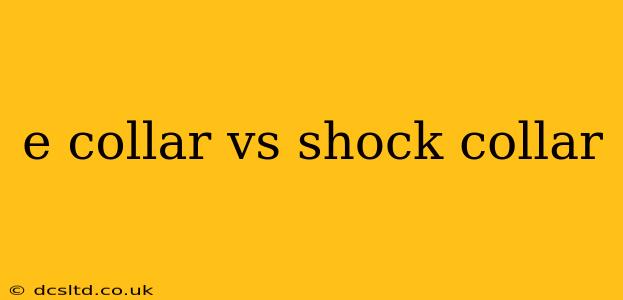The terms "e-collar" and "shock collar" are often used interchangeably, leading to confusion. While they share a common ancestor, there are crucial distinctions that impact their use and ethical considerations. This article will delve into the differences between e-collars and shock collars, helping you make an informed decision if you're considering using one for your dog.
What is an E-Collar?
An e-collar, or electronic collar, is a broad term encompassing a range of devices used for dog training. These collars utilize various methods of stimulation, including:
- Vibration: A gentle buzz that alerts the dog to unwanted behavior. This is often the first and most common setting.
- Tone: An audible beep, similar to a clicker, used as a signal or warning.
- Static Stimulation (Shock): This is the controversial element. The level of stimulation can vary greatly between devices and is often adjustable. Some collars offer very low levels of stimulation, while others deliver stronger shocks.
It's crucial to understand that not all e-collars deliver shocks. Many modern e-collars primarily utilize vibration and tone, offering a humane and effective training method.
What is a Shock Collar?
A shock collar is a specific type of e-collar that primarily uses static stimulation (electric shock) as its primary training method. While the intensity of the shock can be adjusted, the fundamental mechanism relies on delivering an unpleasant electric shock to correct unwanted behavior.
Key Differences Between E-Collars and Shock Collars
The primary difference lies in the primary method of stimulation. E-collars encompass a wider range of stimulation methods, including vibration and tone, whereas shock collars focus solely on electric shock. Many e-collar manufacturers now actively distance themselves from the "shock collar" label, preferring the more neutral "e-collar" to reflect the diversity of their products and training methods.
Are E-Collars Cruel?
The ethical considerations surrounding e-collars, particularly those using shock, are a significant concern. The potential for pain and psychological distress is undeniable. However, the severity of the experience depends heavily on the intensity of the stimulation, the dog's temperament, and the trainer's skill and approach. Proper and ethical use is paramount. Used responsibly and with professional guidance, e-collars can be an effective training tool, but misuse can lead to significant animal welfare issues.
How Do I Choose the Right Collar for My Dog?
Choosing the right collar requires careful consideration:
- Your dog's temperament and training needs: A sensitive dog might benefit from a collar that focuses primarily on vibration and tone. A more stubborn dog might require the addition of static stimulation, but even then, the lowest effective level should be used.
- Your training experience and knowledge: Using an e-collar requires proper training and understanding of canine behavior. It's highly recommended to work with a certified professional dog trainer experienced with e-collar training.
- The collar's features and settings: Look for a collar with adjustable stimulation levels and multiple training modes. Ensure the collar fits your dog comfortably and securely.
Is it better to use positive reinforcement training methods?
Absolutely! Positive reinforcement methods, such as reward-based training with treats and praise, are always the preferred approach. E-collars, even when used correctly, should be considered a secondary tool, not a primary training method. Positive reinforcement builds a stronger bond with your dog and promotes a more positive learning environment.
What are the potential risks and side effects of using an e-collar?
Potential risks and side effects include:
- Skin irritation or burns: If the collar isn't fitted correctly or used improperly.
- Fear and anxiety: If the stimulation is too harsh or inconsistently applied.
- Aggression: If used incorrectly or if the dog develops negative associations with the collar.
Conclusion:
E-collars and shock collars represent a spectrum of training tools. While the term "shock collar" often carries negative connotations due to potential misuse, responsible use of e-collars with a focus on minimal stimulation and professional guidance can, in some circumstances, be part of a well-rounded training plan. However, positive reinforcement methods should always be the foundation of your dog training strategy. Prioritize ethical and humane training practices above all else. Consult a certified professional dog trainer for personalized guidance and to discuss whether an e-collar is appropriate for your dog and your training goals.
